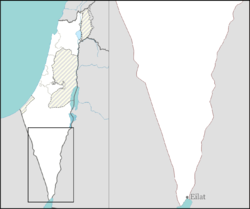Ein Ofarim killings
| Ein Ofarim killings | |
|---|---|
| Part of Palestinian Fedayeen insurgency | |
| Location | Ein Ofarim facility near Hatzeva in Southern Israel |
| Date | September 12, 1956 |
Attack type | Stabbing attack |
| Deaths | 3 Israelis |
| Perpetrators | Palestinian Fedayeen squad |
The Ein Ofarim killings was an attack by Palestinian Fedayeen, which occurred on Wednesday night, 12 September 1956.[1][2][3]
The attack
On Wednesday night, 12 September 1956, a Palestinian Fedayeen squad infiltrated into Israel from Jordan. The militants reached the Ein Ofarim oil-drilling camp near the village Hatzeva, where they killed 3 Druze watchmen.[4][5][6] The three victims, Nawaf Abu-Ghazi (25 years), Suleiman Hatoum (25 years) and Rafik Abdullah (23 years), were burried in their hometown of Sumei and were commemorated on Mount Herzl.[7]
Aftermath
With consulting his Cabinet, the Israeli Prime Minister decided on a reprisal raid.[4] Since the nearest Jordanian police fort was 'topologically difficult', the police fort 80 kilometers away at Gharandal was chosen.[4] During the operation, either 9 or 13 Jordanian police and members of a desert camel patrol unit were killed, along with two civilians.[4] IDF casualties in the operation included one dead soldier and 12 wounded soldiers. The police station and nearby structures were destroyed.[4][8]
References
- ^ "Israel Cites Jordan Raid". Sarasota Herald-Tribune. No. 345. United Press. 14 September 1956. p. 1-2. Retrieved 1 November 2022.
- ^ Ad, Meshulam (14 September 1956). "עקבות רוצחי השומרים הובילו לגבול הירדני" [The traces of the murderers of the guards led to the Jordanian border]. Davar. p. 1 – via National Library of Israel.
- ^ Eilam, Uzi (2020). פשיטה לילית [Night Raid]. Miskal Publishing. p. 47, 193, 292. ISBN 9789652011305.
- ^ a b c d e Morris, Benny (1993). Israel's Border Wars, 1949–1956. Oxford University Press. pp. 409–410. ISBN 0-19-829262-7.
- ^ Gabbai, Sheffi (18 September 1964). "ישן וחדש בנופי ישראל" [Old and new in the landscapes of Israel]. Davar. p. 3 – via National Library of Israel.
- ^ Shai, Nachman, ed. (1988). ביטחון 50: צה"ל, קהיליית המודיעין, משרד הביטחון [Security 50: The IDF, the intelligence community, the Ministry of Defense]. Alfa Tikshoret. p. 20.
- ^ "חללי פעולות האיבה: אזרחים חללי פעולות איבה" [Victims of hostilities: Civilians victims of hostilities]. Bituah Leumi.
- ^ Israeli, Raphael (2002). Jerusalem Divided: The Armistice Regime, 1947-1967. Routledge. p. 82. ISBN 9780714652665.
- Terrorist attacks against Israeli civilians before 1967
- 1956 murders in Israel
- Terrorist attacks attributed to Palestinian militant groups
- Palestinian terrorism
- Terrorist incidents in Asia in 1956
- Terrorist incidents in Israel in the 1950s
- Terrorist incidents involving knife attacks
- Stabbing attacks in Israel
- Palestinian Fedayeen insurgency
- History of the Druze
- Druze community in Israel
- Massacre stubs
- Israel stubs
- Middle Eastern history stubs

